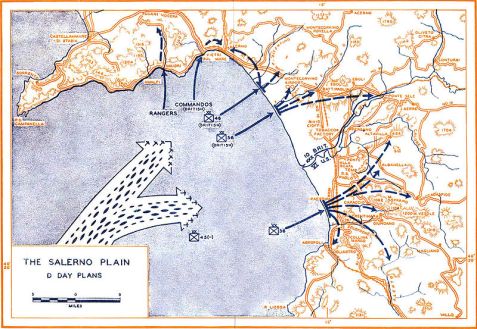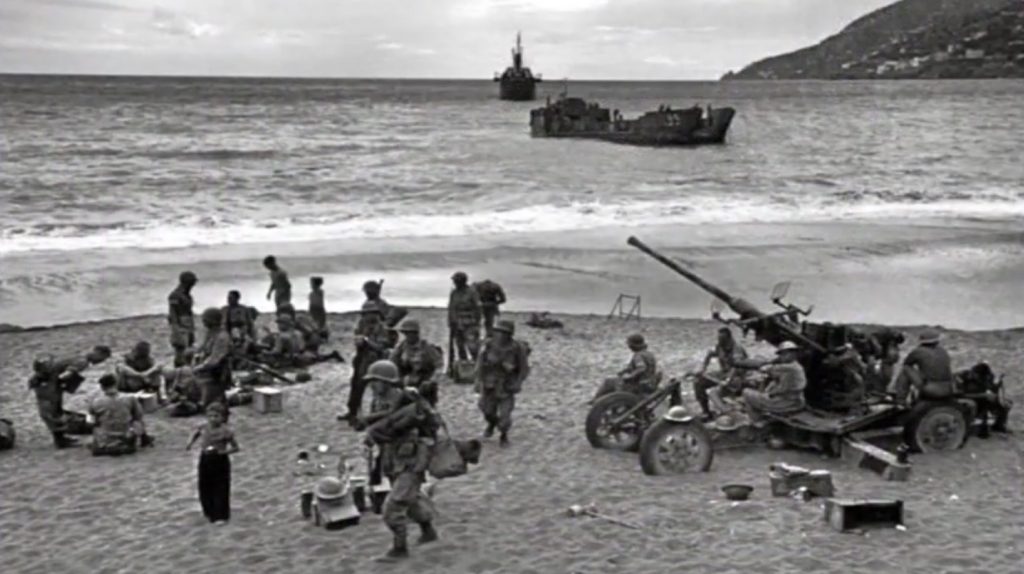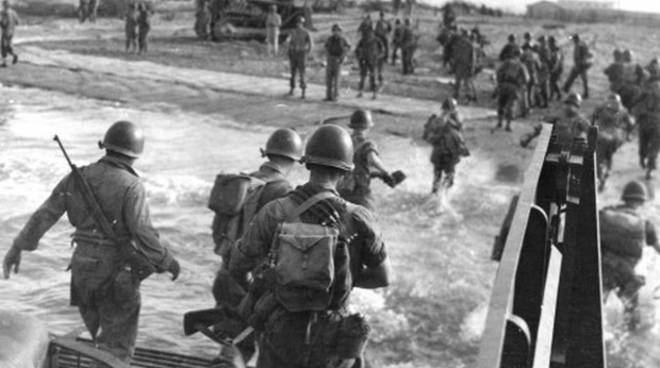L’8 settembre del 1943 il maresciallo Pietro Badoglio, subentrato alla guida del governo dopo il voto di sfiducia del Gran Consiglio del fascismo nei confronti di Mussolini, annuncia all’Italia l’armistizio con gli alleati tramite l’EIAR (Ente Italiano per Audizioni Radiofoniche). La notizia circola anche tra la popolazione salernitana. La guerra è davvero finita? Fin troppo facile a dirsi.

Il 9 settembre del 1943 il Generale Clark, al comando della quinta armata statunitense, delegato dal generale Eisenhower, diede inizio allo Sbarco di Salerno. L’operazione militare, chiamata “Avalanche” fu attuata dagli Alleati con l’intento di aprire un nuovo fronte nel conflitto, da cui iniziare ad attaccare i territori controllati dall’Asse. L’operazione sul golfo salernitano fu di portata enorme con una flotta che contava mille navi e circa 160.000 soldati, cifre, queste, non dissimili da quelle impiegate l’anno successivo, 1944, durante lo Sbarco in Normandia in cui si contavano tra i 160.000 e i 180.000 soldati. Si trattava del più grande sbarco della storia, superato,appunto, nel 1944 dallo sbarco in Normandia.
La scelta di Salerno, per essere più precisi i luoghi limitrofi della piana del Sele, fu un ripiego dovuto al non poter attaccare il troppo sicuro e controllato porto di Napoli. Le prime navi iniziarono a sbarcare sul litorale salernitano alle ore 3:30 del 9 settembre su una fascia costiera estesa per circa sessanta chilometri da Maiori, in costiera amalfitana, ad Agropoli, nel Cilento. La battaglia tra le forze alleate capitanate dal generale Clark e i tedeschi con a capo il generale Albert Kesselring fu tutt’altro che semplice, durò settimane e coinvolse anche i civili. Pur essendo in netta minoranza i tedeschi non si diedero per vinti, anzi, opposero una potente offensiva riuscendo anche a rallentare le truppe anglo-americane, grazie soprattutto alla conoscenza del territorio.

Dopo giorni di combattimenti continui le truppe alleate, ormai stanche e provate, cominciarono la controffensiva facendo giungere una nave dalla base di Malta con l’intento principale di bombardare la costa salernitana e, contemporaneamente, attaccarono anche via aerea creando forte scompiglio nelle forze tedesche. Grazie alla collaborazione e alla tenacia mantenuta dalle forze alleate la controffensiva risultò decisiva per l’intera operazione, garantendone il successo.

Avalanche si concludeva definitivamente il 1° ottobre 1943, quasi un mese dopo lo sbarco sul litorale salernitano, con l’arrivo del generale Clark e della sua armata nel porto di Napoli, obiettivo principale delle forze alleate, già liberata dai tedeschi in seguito ad un’insurrezione popolare, passata alla storia come le “quattro giornate di Napoli”. L’operazione militare e gli scontri avevano lasciato il segno sul territorio salernitano: tutta la zona era stata testimone di intensi combattimenti e città come Battipaglia, Sarno e Scafati furono rase al suolo.
A partire da ottobre lo scontro con i tedeschi si spostò verso il nord della Penisola: cominciava così la lunga e faticosa marcia verso la Liberazione, lasciandosi alle spalle macerie, lutti, una popolazione stremata dalla fame e dalle lotte continue, oltre rapporti con i vincitori non sempre facili a causa delle grandi differenze culturali e dalle difficoltà dell’occupazione.
Operation Avalanche, 9th September 1943
On 8th September 1943, Marshal Pietro Badoglio, who took over the leadership of the government after the vote of no confidence of the Grand Council of Fascism towards Mussolini, announced to Italy the armistice with the allies through the EIAR (Ente Italiano per Audizioni Radiofoniche, Italian Body for Radio Auditions). The news also circulates among the Salerno population. Is the Great War over? All too easy to say.
On 9th September 1943, General Clark, in command of the US Fifth Army, delegated by General Eisenhower, began the Salerno Landing. The military operation, called “Avalanche” was carried out by the Allies with the intent of opening a new front in the conflict, from which to start attacking the territories controlled by the Axis. The operation on the Gulf of Salerno was of enormous scope with a fleet of a thousand ships and about 160,000 soldiers. These figures were similar to those employed the following year (1944) during the Normandy Landing in which there were between 160,000 and 180,000 soldiers. It was the largest landing in history, surpassed, as said, in 1944 by the landing in Normandy.
The choice of Salerno, to be more precise of the neighbouring places of the Sele plain, was a makeshift due to not being able to attack the too safe and controlled port of Naples. The first ships began to disembark on the Salerno coast at 3:30am on 9th September on a coastal strip extending for about sixty kilometres from Maiori, on the Amalfi coast, to Agropoli, in Cilento. The battle between the allied forces, led by General Clark, and the Germans, led by General Albert Kesselring, was anything but simple: it lasted weeks and involved civilians. Despite being in a clear minority, the Germans did not give up, on the contrary, they opposed a powerful offensive and managed to slow down the Anglo-American troops, thanks above all to the knowledge of the territory.
After days of continuous fighting, the allied troops, now tired, began the counter-offensive by bringing a ship from the base of Malta with the main intent of bombing the Salerno coast and, at the same time, they also attacked by air, creating strong confusion in the German forces. Thanks to the collaboration and tenacity maintained by the allied forces, the counter-offensive was decisive for the entire operation and guaranteed its success.
Avalanche ended definitively on 1st October 1943, almost a month after landing on the Salerno coast, with the arrival of General Clark and his army in the port of Naples: the main target of the allied forces, already liberated from the Germans thanks to a popular uprising, which went down in history as the “four days of Naples”. The military operation and the clashes had left their mark on the Salerno area: the whole area had witnessed intense fighting and cities such as Battipaglia, Sarno and Scafati were razed to the ground. Starting from October the clash with the Germans moved towards the north of the Peninsula: thus began the long and tiring march towards Liberation, leaving behind rubble, mourning, a population exhausted by hunger and continuous struggles, in addition to relations with the winners not always easy due to the great cultural differences and the difficulties of the military occupation.


Bibliografia:
- A. Capano e A. Lampugnani, Eboli, Il Saggio, 2014, pag.25. Memorie di guerra. Il Cilento e il Salernitano prima, durante e dopo l’operazione Avalanche.
- J. Miller, Univesity of North Carolina,1986, The United States and Italy 1940-1950: The Politics and Diplomacy of Stabilization
- A. Pesce, Salerno 1943. Operation Avalanche, Albertelli, Parma, 1996
- A. G Steiger., The Campaign in Southern Italy (September-December 1943)
Sitografia:
- https://www.focus.it/cultura/storia/9-settembre-1943-lo-sbarco-a-salerno
- https://www.comune.napoli.it/flex/cm/pages/ServeBLOB.php/L/IT/IDPagina/15366
- http://www.archiviodistatosalerno.beniculturali.it/Risorse/scaricabili/schegge.pdf
- http://www.me-dia-re.it/alleati-sbarcano-salerno-09-09-1943/
- https://fimd.it/moa-museum-of-operation-avalanche/
Opération Avalanche, 9 septembre 1943.
Le 8 septembre 1943, le maréchal Pietro Badoglio, qui prend la tête du gouvernement après le vote de défiance du Grand Conseil du fascisme envers Mussolini, annonce à l’Italie l’armistice avec les alliés par l’intermédiaire de l’EIAR (Organe italien pour les audiences radio) . La nouvelle circule également parmi la population de Salerne. La guerre est-elle vraiment finie ? Trop facile à dire.
Le 9 septembre 1943, le général Clark, commandant la 5e armée américaine, délégué par le général Eisenhower, entame le débarquement de Salerne. L’opération militaire, appelée “Avalanche”, a été menée par les Alliés avec l’intention d’ouvrir un nouveau front dans le conflit, à partir duquel commencer à attaquer les territoires contrôlés par l’Axe. L’opération sur le golfe de Salerne était d’une envergure énorme avec une flotte qui comptait un millier de navires et environ 160 000 soldats, des chiffres qui ne sont pas sans rappeler ceux employés l’année suivante, 1944, lors du débarquement de Normandie dans lequel ils comptaient entre 160 000 et 180 000 soldats. Ce fut le plus grand débarquement de l’histoire, dépassé, en effet, en 1944 par le débarquement de Normandie.
Le choix de Salerne, pour être plus précis des localités voisines de la plaine du Sele, était un pis-aller faute de pouvoir attaquer le port trop sûr et contrôlé de Naples. Les premiers navires ont commencé à débarquer sur la côte de Salerne à 3 h 30 le 9 septembre sur une bande côtière s’étendant sur une soixantaine de kilomètres de Maiori, sur la côte amalfitaine, à Agropoli, dans le Cilento. La bataille entre les forces alliées dirigées par le général Clark et les Allemands dirigés par le général Albert Kesselring était tout sauf simple, elle a duré des semaines et a également impliqué des civils. Bien que les Allemands soient en nette minorité, ils ne baissent pas les bras, au contraire, ils s’opposent à une puissante offensive et parviennent également à ralentir les troupes anglo-américaines, grâce avant tout à la connaissance du territoire.
Après des jours de combats continus, les troupes alliées, maintenant fatiguées et épuisées, ont commencé la contre-offensive en amenant un navire de la base de Malte avec l’intention principale de bombarder la côte de Salerne et, en même temps, elles ont également attaqué par voie aérienne , créant une grande confusion dans les forces allemandes. Grâce à la collaboration et à la ténacité entretenues par les forces alliées, la contre-offensive a été décisive pour l’ensemble de l’opération, garantissant son succès.
L’avalanche prend fin définitivement le 1er octobre 1943, près d’un mois après le débarquement sur la côte de Salerne, avec l’arrivée du général Clark et de son armée dans le port de Naples, cible principale des forces alliées, déjà libérées par les Allemands à la suite d’un soulèvement populaire. , qui sont entrés dans l’histoire comme les “quatre jours de Naples”. L’opération militaire et les affrontements ont laissé des traces dans la région de Salerne : toute la région a été le théâtre d’intenses combats et des villes comme Battipaglia, Sarno et Scafati ont été rasées.
À partir d’octobre, l’affrontement avec les Allemands s’est déplacé vers le nord de la Péninsule : ainsi a commencé la longue et fatigante marche vers la Libération, laissant derrière lui des décombres, le deuil, une population épuisée par la faim et des luttes incessantes, ainsi que des relations avec les vainqueurs. toujours facile en raison des grandes différences culturelles et des difficultés d’emploi.
Operación Avalanche, 9 semptiembre 1943.
El 8 de septiembre de 1943, el mariscal Pietro Badoglio, que había asumido el gobierno después del voto de desconfianza del Gran Consejo del fascismo contra Mussolini, anunció a Italia el armisticio con los aliados a través del EIAR (Ente Italiano para Audiciones Radiofónicas). La noticia circula también entre la población salernitana. ¿Realmente ha terminado la guerra? Demasiado fácil de decir. El 9 de septiembre de 1943, el general Clark, al mando del Quinto Ejército de los Estados Unidos, delegado del general Eisenhower, inició el Desembarco de Salerno. La operación militar, llamada “Avalanche” fue implementada por los Aliados con la intención de abrir un nuevo frente en el conflicto, desde el cual comenzar a atacar los territorios controlados por el Eje. La operación en el golfo de Salerno fue de enorme alcance con una flota que contaba con mil barcos y unos 160.000 soldados, estas cifras, no diferentes de las empleadas el año siguiente, 1944, durante el Desembarco en Normandía en el que se contaban entre 160.000 y 180.000 soldados. Fue el mayor desembarco de la historia, superado en 1944 por el Desembarco de Normandía.
La elección de Salerno, para ser más precisos los lugares vecinos de la llanura de Sele, fue un repliegue debido a no poder atacar el puerto de Nápoles demasiado seguro y controlado. Los primeros barcos comenzaron a desembarcar en el litoral salernitano a las 3:30 del 9 de septiembre en una franja costera extendida por unos sesenta kilómetros desde Maiori, en la costa amalfitana, hasta Agropoli, en Cilento. La batalla entre las fuerzas aliadas lideradas por el general Clark y los alemanes al mando del general Albert Kesselring no fue fácil, duró semanas y también involucró a civiles. A pesar de ser una clara minoría, los alemanes no se dieron por vencidos, sino que opusieron una poderosa ofensiva y lograron frenar a las tropas angloamericanas, gracias sobre todo al conocimiento del territorio. Después de días de continuos combates las tropas aliadas, ya cansadas y probadas, iniciaron la contraofensiva haciendo llegar un barco desde la base de Malta con la intención principal de bombardear la costa salernitana y, Al mismo tiempo, también atacaron por aire, causando una gran conmoción en las fuerzas alemanas. Gracias a la colaboración y tenacidad mantenida por las fuerzas aliadas, la contraofensiva resultó decisiva para toda la operación, garantizando su éxito. Avalanche concluyó definitivamente el 1 de octubre de 1943, casi un mes después del desembarco en el litoral salernitano, con la llegada del general Clark y de su ejército al puerto de Nápoles, objetivo principal de las fuerzas aliadas, ya liberada por los alemanes tras una insurrección popular, pasada a la historia como las “cuatro jornadas de Nápoles”. La operación militar y los enfrentamientos habían dejado huella en el territorio salernitano: toda la zona había sido testigo de intensos combates y ciudades como Battipaglia, Sarno y Scafati fueron arrasadas. A partir de octubre el enfrentamiento con los alemanes se desplazó hacia el norte de la Península: comenzaba así la larga y fatigosa marcha hacia la Liberación, dejando atrás escombros, lutos, una población agotada por el hambre y las luchas continuas, más allá de las relaciones con los ganadores no siempre fáciles debido a las grandes diferencias culturales y las dificultades del empleo.
Bibliografia:
- A. Capano e A. Lampugnani, Eboli, Il Saggio, 2014, pag.25. Memorie di guerra. Il Cilento e il Salernitano prima, durante e dopo l’operazione Avalanche.
- J. Miller, Univesity of North Carolina,1986, The United States and Italy 1940-1950: The Politics and Diplomacy of Stabilization
- A. Pesce, Salerno 1943. Operation Avalanche, Albertelli, Parma, 1996
- A. G Steiger., The Campaign in Southern Italy (September-December 1943)
Sitografia:
- https://www.focus.it/cultura/storia/9-settembre-1943-lo-sbarco-a-salerno
- https://www.comune.napoli.it/flex/cm/pages/ServeBLOB.php/L/IT/IDPagina/15366
- http://www.archiviodistatosalerno.beniculturali.it/Risorse/scaricabili/schegge.pdf
- http://www.me-dia-re.it/alleati-sbarcano-salerno-09-09-1943/
- https://fimd.it/moa-museum-of-operation-avalanche/